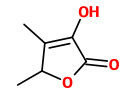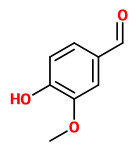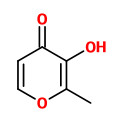Saccharum officinarum L. - Poaceae - sugarcane, Zuckerrohr
Perennial, forming tall clumps, culms 3-6m tall, leaves 70-150cm ong, usually glabrous, margins sharply serrate; panicle 50-100cm, racemes 10-25cm, spikelets 3.5-4mm, callus hairs 2-3 times length of spikelet, lower glume oblong, lower lemma oblong-lanceolate, upper lemma linear.
Widely cultivated as commercial crop in tropical regions of the world. „Most present-day cultivars contain genes from Saccharum spontaneum. Sugar is extracted from the soft, central tissue of the culm. The dyed inflorescence is used as an ornament.“
http://www.efloras.org/florataxon.aspx?flora_id=2&taxon_id=200026232
Regarding the compounds responsible for the sugary flavor of raw cane sugar and cane molasses, the most important key compound of the sugary flavor was identified to be 3-hydroxy-4,5-dimethyl-2[5H]-furanone (sotolon).
[Tokitomo, Yukiko, et al. „Studies on the “Sugary Flavor” of Raw Cane Sugar. III.“ Proceedings of the Japan Academy, Series B 56.7 (1980): 457-462.] https://www.jstage.jst.go.jp/article/pjab1977/56/7/56_7_457/_pdf
4-Hydroxy-3-methoxybenzaldehyde (vanillin), 3-hydroxy-2-methyl-4-pyranone (maltol), 2-hydroxy-3-methyl-2-cyclopentenone (cyclotene, maple lactone), 4-nonanolide (gamma nonalactone), 4-vinylphenol, and 2,6-dimethoxyphenol were also thought to contribute to the sugary flavor. „These aroma components seemed to be a mixture of naturally occurring products of sugarcane and by products arising during raw cane sugar manufacturing with a high temperature (105°C) and akaline conditions… sugary flavor components, 3-hydroxy-2-methyl-4-pyranone and 2-hydroxy-3-methyl-2-cyclopentenone, could not be found in fresh cane juice and these typical volatile products were assumed to be formed from sugar by heating.“
Sotolon could not be identified in fresh cane juice, but its presence is undeniable because the odor threshold value of sotolon is very low (0.01 ppb in water) and the characteristic aroma could not be regenerated by mixing the identified compounds alone.
[Tokitomo, Yukiko, Akio Kobayashi, and Tei Yamanishi. „Aroma components of fresh sugar cane juice.“ Agricultural and Biological Chemistry 48.11 (1984): 2869-2870] https://www.jstage.jst.go.jp/article/bbb1961/48/11/48_11_2869/_pdf

Saccharum officinarum L.; Köhler, F.E., Medizinal Pflanzen, vol.2 t.169 (1890)
http://botanicalillustrations.org/species.php?id_species=896917&SID=0&size=1

Saccharum officinarum, Morona, Ecuador (2025)
© UEF Don Bosco Macas CC BY-SA 4.0 inaturalist.org


